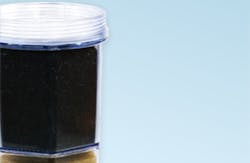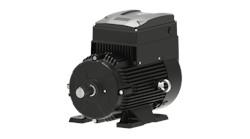Editor’s note:This is Part two of Water Technology’sOctober issue feature titled, “Activated carbon software programs improve operations.” In Part one, Dr. Nowicki discussed activated carbon (AC) performance predictions as well as ASTM software. If you missed Part one, please visit WaterTechOnline.com to read this article in its entirety.
Refractive index determination
A molecule’s refractive index (RI) is important for physical adsorption because it is related to the molecule’s polarizability. As a general rule, higher molecular RI results in better adsorption capacity. Polarizability should not be confused with the molecular polar concept. Polarizability is related to looseness of outer shell non-bonding electrons.
If you know bonds in a molecular structure of any molecule, you can easily determine the RI using this software. Each type of chemical bond has an assigned value. RI is an additive summation of all compound molecular bonds. You can use RI as a relative measure of molecular binding to activated carbon (AC) platelet surfaces.
A RI measurement of 1.5 or higher is a very good AC adsorbate; it loads quickly and heavily on AC. Such a molecule has outer shell electrons which can be manipulated by AC graphitic platelets force field. In physical adsorption, adsorbates are held onto the AC surface of adsorbent by electrostatic forces called Van der Waals forces — Van der Waal developed five phenomena which attract molecules together. This specific Van der Waal force is also called London Dispersion force. Named after Fritz London, who came up with an explanation for why increasing the pressure of gaseous argon resulted in premature condensation of gas to liquid, before it reached the theoretical pressure for condensation, which assumes inert argon.
Different types of feedstocks for manufacturing AC, including coal, wood and coconut shell, have different sized graphitic platelets. Random ordering of these graphitic platelets creates different sizes of distribution of adsorption spaces or pores, where contaminants are removed from the mobile gas- or liquid-phase. Outer molecular electrons of adsorbates are converted from a neutral configuration to plus (electron deficient) and minus (electron rich) locations on the molecule’s surface. This provides relatively negative and positive locations on the molecule surface, which aids electrostatic to stick together when they are close neighbors.6
Adsorption is very dependent on the distance of adsorbate to AC graphitic platelet surface. A molecule that is one molecular layer away from AC service has a relative binding strength of one. At two molecular layers away, relative force is 1/8, and at three layers away, binding force is 1/27 relative to one molecular layer away. AC binding force and molecular distance relationship is a power of three. Molecules further than three molecular layers away from the AC surface are not adsorbed. The binding force does not depend on temperature. A larger molecule adsorbs better than a smaller molecule. A dimer binds two times the monomer force. A stronger binding molecule can displace a previously adsorbed molecule, and this is called rollover.
RI for compounds of interest may be difficult to find in open literature, however, software can quickly be used to determine the RI of any compound of interest.
Gravimetric adsorption energy distribution (GAED) full characterization
GAED software provides a cornucopia of information about specific activated carbons for gas- or aqueous-phase physical adsorption application opportunities. Besides isotherms, GAED offers: Pore size distribution, BET surface area, trace-capacity number, mid-capacity number, pore or adsorption space volume as a function of adsorption energy density and total pore volume for individual sample and much more.
GAED is the best AC characterization test available. We have provided over 5,000 samples, using GAED. GAED provides full characterization of vapor-, aqueous- or solvent-phases.6
Received and dry American Society for Testing (ASTM) apparent densities for AC test material are determined. This enables presenting AC adsorption data on a volume basis. Most clients fill a container with granular activated carbon (GAC), so volume comparisons are more useful than weight-based comparisons. The dried material is placed in GAED instrument sample compartment. It is heated to 250o C with a flowing inert argon gas stream, to take away any volatiles and clean the sample. After the sample is cleaned, weight lost at 250o C is reported as a measure of sample cleanliness — two percent or less weight lost is good. When comparing multiple samples, they need to all be cleaned and you must know the starting amount of contamination before adding the challenge adsorbate gas.
TFE, or 1,1,1,2-Tetrafluoroethane, was chosen as the challenge gas because TFE outer shell electrons are tightly held with a RI measurement of 1.200 and thus has an exceptionally low polarizability. After a 250o C sample cleaning, TFE is added by flowing through the sample; then a temperature program cools the sample to above the TFE condensation temperature at minus 21o C. This avoids sample weight gain from TFE condensation on the tested sample. About 700 sample weight gain values during cool down, due to physical adsorption, are acquired. Then the temperature program is reversed back to 250o C to obtain a loaded sample desorption curve. Out of some 1,400 data points for adsorption and desorption, software selects 30 representative data points from quasi-equilibrium weights. This provides a data table and graphical presentation, called Characteristic Curve, for the specific AC sample that was run.
From the Characteristic Curve, the Y-axis is pore volume, in cc of TFE adsorbate per 100 cc of material, versus adsorption energy density on the X-axis, in calories per cc adsorption space or pore volume. Software determines the polynomial equation from the Characteristic Curve distribution. This equation enables isotherm determinations for any compounds of interest at any process temperature. The pore size distribution, BET surface area and more are calculated.
Standard sorbents are used as benchmark controls for comparison and to prove that the GAED instrument is performing within statistical performance limits. Three standard compound isotherms are provided: Methyl-tertiary-butyl-ether (MTBE), benzene and phenol. These three compounds cover the range from weak-, medium- and strong-adsorption capacities in water. Once a specific sorbent adsorption space is mapped with TFE- GAED full characterization, we can supply isotherms for any compounds of interest at any temperature desired. We only need to ratio the molar volume of the compound of interest to TFE molar volume in order to get a specific compound’s Characteristic Curve and thus its isotherms. Also, relative refractive indices can be used to re-map adsorption space distribution for specific compounds outside of the three standards given.
What GAED provides you
GAED instrument-software delivers a gas-phase precise measurement which provides economic physical adsorption information. Polanyi model connects gas- and aqueous-phase physical adsorption. Classical ASTM isotherms and Characteristic Curves are inter-convertible. If you have an isotherm, it can be transformed into a Characteristic Curve. A GAED directly provides the most important isotherm information; isotherms tell us if sorbent is economical for an application and if the AC has working performance to satisfy a specific sorbent application. A GAED affords selecting the best sorbent for the application.
Summary
Software programs improve AC operations including: The initial purchase, life-cycle performance monitoring, determining when to replace used with unused GAC, choosing best replacement GAC and determining what thermal activation does to used AC porous structures. It is important to understand what each test method provides. Advanced test methods are available to solve problems not solved by classical standard methods. Operations who employ smart software improve management of operations and productivity.
I recommend that installed GAC should be analyzed by GAED and ASTM test methods. When installing AC, save a representative sample in a closed clean container. This action provides the starting adsorption spaces or pores available to remove contaminants. After the GAC is used, run another GAED characterization and compare to the initial GAC. This GAC difference in used adsorption spaces reveals specific pores needed for specific water treatment applications. Knowing the needed pores can help select the best carbon in the future.
Acknowledgments
Henry Nowicki, Ph.D./M.B.A., would like to thank his prior staff — Homer Yute, Dr. Milton Manes and Dr. Mick Greenbank — and present staff — Christopher Brunning and George Nowicki — for contributing to this software and instrumentation.
Sources
- Milton Manes, Ph.D., Fundamentals of Activated Carbon Adsorption. Available electronically by contacting author.
- ASTM D3860-98 Standard Test Methods for Determination of Adsorptive Capacity of Activated Carbon by Aqueous Phase Isotherm Technique.
- ASTM D5919-96 for Determination of Adsorptive Capacity of Activated Carbon by Micro-Isotherm Technique.
- ASTM D2862-97 Standard Test Method for Particle Size Distribution of Granular Activated Carbon.
- ASTM D3802 Standard Test Methods for Ball-Pan Hardness of Activated Carbon.
- Henry Nowicki, et al. Water Conditioning & Purification. Go to wcponline.com and type “Nowicki” into the search box to get reprints.
Henry Nowicki, Ph.D./M.B.A., president of PACS and Activated Carbon Services, provides routine and advanced independent laboratory activated carbon testing, R&D, consulting, expert witness services and short training courses. He also hosted the 34th International Activated Carbon Conference, which took place Sept. 25 – 26, 2014, near Pittsburgh, Pennsylvania, as well as associated carbon courses held Sept. 22 – 27, 2014; he will host the 35th International Activated Carbon Conference in Orlando, Florida, in February 2015 and 36th International Activated Carbon Conference in Pittsburgh, Pennsylvania, September 2015. For more information visit Pacslabs.com, call (724) 457-6576 or email [email protected].


